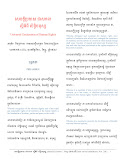Our sincere thanks to Lok Bora Touch, Esq. for forwarding this interesting piece of information on Angkor Borei archeology.
Where was "Temu", capital of Funan? -- S.T. Lee Annual Lecture in Asian Art and Archaeology 2010
"Temu", the Funan's capital, was estimated to be 500 li from Funan's seaport, according to the Chinese envoys.
Oc Eo (Khmer, Keo river), believed by some as the port of the Funan (2th-7th century); but Oc Eo was not situated directly at the coast of the bay of Rach Gia province. At no time was there a port by which the Chinese envoys could enter the Funan polity. Additionally, there are no records mentioning a port at Rach Gia during or after Funan. But Peam Meas (from which "Meitho" derives) is known as a khmer port. Peam means "mouth" of a river or a lake, it also means "(water) port". (Thai, "Pa(k)" came from Khmer "Peam", Pac-nam mouth of the river) Peam Ro, for instance, in Prey Veng, was an ancient port of Ba Phnom. Peam Meas might have been the Funan's seaport the Chinese envoys mentioned. From Peam Meas, the Chinese envoys could (via the Mekong) enter the Ba Phnom's port of Peam Ro.
Now, the distance of 500 li or 200 km from the sea to the capital of funan, as estimated by the Chinese envoys recorded in 6th century cannot be seen from Oc Eo site. And it could not have been Angkor Borei, Takeo, as Angkor Borei was/is only about 85 km from O Keo/Oc Eo, and shorter in distance from Pean Meas/Meithor. Ba Phnom, Prey Veng, loosely fits the distance description by the Chinese envoys. Archaeological finds/riches at Prohear village, and Bit Meas, in Prey Veng, supports the description that Prey Veng's Ba Phnom might have been the capital of Funan, the Rich South.
Bora Touch
-----------------
The Lee Annual Lecture in Asian Art and Archaeology will be held in the Refectory of the Main Quadrangle of the University of Sydney from 6pm Wednesday 11th August 2010. This years lecture will be given by Professor Miriam Stark, Archaeologist, University of Hawaii-Manoa, United States of America.
The Mekong Delta Before Angkor: origins, landscapes and emergent complexity
The earliest states in mainland Southeast Asia emerged between 500 BCE and 500 CE, a period known as the Axial Age. In the West, this time encompassed Hellenistic Greece, the rise of the Roman Empire, and the birth of Christianity. Viewed from the East, the period included imperial expansion by the Han dynasty, the rise of the earliest Korean and Japanese kingdoms, the spread of Buddhism across the Asian continent, and rise of competing empires during the golden age of South Asia. Southeast Asians also embraced this Axial Age, although few historians or archaeologists have studied the period until recently. During this time Southeast Asians established a South China Sea maritime trade network and built large settlements along the region’s coasts and inland deltas. They adopted writing systems and religious ideology from South Asia, and created Indic-tinged templates for statecraft whose signatures shaped the emergence and operation of Southeast Asia's classical states like Angkor, Sukothai, and Pagan nearly a thousand years later.
Professor Miriam Stark has worked in collaboration with Cambodia's Ministry of Culture and Fine Arts since 1996 on the archaeology of the Mekong Delta. This region was politically central during the Axial Age, and work by her Lower Mekong Archaeological Project began with research at the archaeological site of Angkor Borei (Takeo province). Most scholars consider that this 300 ha walled site was a Funan capital that the Chinese annals described during the early to mid-first millennium CE. The region remained prominent in the following pre-Angkorian period, and research described in this lecture examines archaeological research by the Lower Mekong Archaeological Project on landscapes and emergent complexity.
Date: Wednesday 11th August 2010
Time: 6 - 8pm
Location: Refectory of the Main Quadrangle of the University of Sydney (http://www2.arts.usyd.edu.au/ArtsNetwork/docs/main_quad_instr.pdf)
RSVP: Monday 9th August 2010 (Martin King - 9351-7667 or martin.king@sydney.edu.au)
Miriam Stark was awarded a PhD from the University of Arizona in 1993, and has worked in Southeast Asian archaeology since 1987. With extensive field experience in North America (particularly the North American Southwest), she studied tribal potters in the northern Philippines for her doctoral research. She worked with the Thailand Archaeometallurgical project in central Thailand in the early 1990s, and “ after accepting a position at the University of Hawaii-Manoa -- began her archaeological studies in Cambodia. Through the Lower Mekong Archaeological Project and in collaboration with Cambodia's Ministry of Culture and Fine Arts, Miriam has worked in the Mekong delta since 1996. The Lower Mekong Archaeological Project blends field research with training, and examines state formation and landscape evolution in the first millennium CE. She has joined the Greater Angkor Project for the 2010-2015 research program.
Oc Eo (Khmer, Keo river), believed by some as the port of the Funan (2th-7th century); but Oc Eo was not situated directly at the coast of the bay of Rach Gia province. At no time was there a port by which the Chinese envoys could enter the Funan polity. Additionally, there are no records mentioning a port at Rach Gia during or after Funan. But Peam Meas (from which "Meitho" derives) is known as a khmer port. Peam means "mouth" of a river or a lake, it also means "(water) port". (Thai, "Pa(k)" came from Khmer "Peam", Pac-nam mouth of the river) Peam Ro, for instance, in Prey Veng, was an ancient port of Ba Phnom. Peam Meas might have been the Funan's seaport the Chinese envoys mentioned. From Peam Meas, the Chinese envoys could (via the Mekong) enter the Ba Phnom's port of Peam Ro.
Now, the distance of 500 li or 200 km from the sea to the capital of funan, as estimated by the Chinese envoys recorded in 6th century cannot be seen from Oc Eo site. And it could not have been Angkor Borei, Takeo, as Angkor Borei was/is only about 85 km from O Keo/Oc Eo, and shorter in distance from Pean Meas/Meithor. Ba Phnom, Prey Veng, loosely fits the distance description by the Chinese envoys. Archaeological finds/riches at Prohear village, and Bit Meas, in Prey Veng, supports the description that Prey Veng's Ba Phnom might have been the capital of Funan, the Rich South.
Bora Touch
-----------------
S.T. Lee Annual Lecture in Asian Art and Archaeology 2010
The Lee Annual Lecture in Asian Art and Archaeology will be held in the Refectory of the Main Quadrangle of the University of Sydney from 6pm Wednesday 11th August 2010. This years lecture will be given by Professor Miriam Stark, Archaeologist, University of Hawaii-Manoa, United States of America.
The Mekong Delta Before Angkor: origins, landscapes and emergent complexity
The earliest states in mainland Southeast Asia emerged between 500 BCE and 500 CE, a period known as the Axial Age. In the West, this time encompassed Hellenistic Greece, the rise of the Roman Empire, and the birth of Christianity. Viewed from the East, the period included imperial expansion by the Han dynasty, the rise of the earliest Korean and Japanese kingdoms, the spread of Buddhism across the Asian continent, and rise of competing empires during the golden age of South Asia. Southeast Asians also embraced this Axial Age, although few historians or archaeologists have studied the period until recently. During this time Southeast Asians established a South China Sea maritime trade network and built large settlements along the region’s coasts and inland deltas. They adopted writing systems and religious ideology from South Asia, and created Indic-tinged templates for statecraft whose signatures shaped the emergence and operation of Southeast Asia's classical states like Angkor, Sukothai, and Pagan nearly a thousand years later.
Professor Miriam Stark has worked in collaboration with Cambodia's Ministry of Culture and Fine Arts since 1996 on the archaeology of the Mekong Delta. This region was politically central during the Axial Age, and work by her Lower Mekong Archaeological Project began with research at the archaeological site of Angkor Borei (Takeo province). Most scholars consider that this 300 ha walled site was a Funan capital that the Chinese annals described during the early to mid-first millennium CE. The region remained prominent in the following pre-Angkorian period, and research described in this lecture examines archaeological research by the Lower Mekong Archaeological Project on landscapes and emergent complexity.
Date: Wednesday 11th August 2010
Time: 6 - 8pm
Location: Refectory of the Main Quadrangle of the University of Sydney (http://www2.arts.usyd.edu.au/ArtsNetwork/docs/main_quad_instr.pdf)
RSVP: Monday 9th August 2010 (Martin King - 9351-7667 or martin.king@sydney.edu.au)
Miriam Stark was awarded a PhD from the University of Arizona in 1993, and has worked in Southeast Asian archaeology since 1987. With extensive field experience in North America (particularly the North American Southwest), she studied tribal potters in the northern Philippines for her doctoral research. She worked with the Thailand Archaeometallurgical project in central Thailand in the early 1990s, and “ after accepting a position at the University of Hawaii-Manoa -- began her archaeological studies in Cambodia. Through the Lower Mekong Archaeological Project and in collaboration with Cambodia's Ministry of Culture and Fine Arts, Miriam has worked in the Mekong delta since 1996. The Lower Mekong Archaeological Project blends field research with training, and examines state formation and landscape evolution in the first millennium CE. She has joined the Greater Angkor Project for the 2010-2015 research program.
For additional information about this research, click here
To read a recent paper by Dr. Stark, click here
To read a recent paper by Dr. Stark, click here


























11 comments:
Yes, we can be proud of the accomplishments of our ancestors. Now ask ourselves this question: Would our ancestors be proud of us ? Personally I don't think they would.
I am from Takeo. Thanks for the article.
That is right. Baphnom has always been considered as the Capital of Funan. Just read George Coedes. But later on some historians rejected this hypothesis. But it does not mean that Angkor Borei was not important, as later on Angkor Borei became the capital of Water Chenla. In those days, lives were structured around cities, and Angkor Borei was a prosperous city, as testified by early Khmer culture.
thank you for sharing your knowledge of khmer history.
i'm also from takeo Kbal po .
To Khmer rouges from Takeo: NIRDEI
In 1975, you killed a lot of Khmer republicans.
From 1976 to 1979, you killed a lot of Khmer rouges yourself and also Khmer republicans.
You come really from killer blood.
Was Ta Mok, Khmer Rouge fierceful commander, from Takeo, too.
There was a famous known that
Khmer Rouge cardes sent from Takeo to Battanbang province in 1977 were very cruelty and merciless.
I'm from kompong Cham. The land of Sdeachkorn
Khmers was living in Suvannaphumi over two thousand years ago. We built Funan, Chenla, Norkorphnom, and Mohanorkor. We appreciate to our great grand ancestors.
wath Suvannaphumi shit?
Suvannaphumi: The place of the Golden country. Kompuchea is Suvanna Phumi. The Southeast Asia there are without Thailand, Vietnam, and Lao. Suvannaphumi was created in the second century after Queen Livyi passed away.
2:58 AM you're a fag if you've never heard of sovannaphum. Real Khmers know about the land of gold, our land before those savages pillaged the shit out of it.
Post a Comment